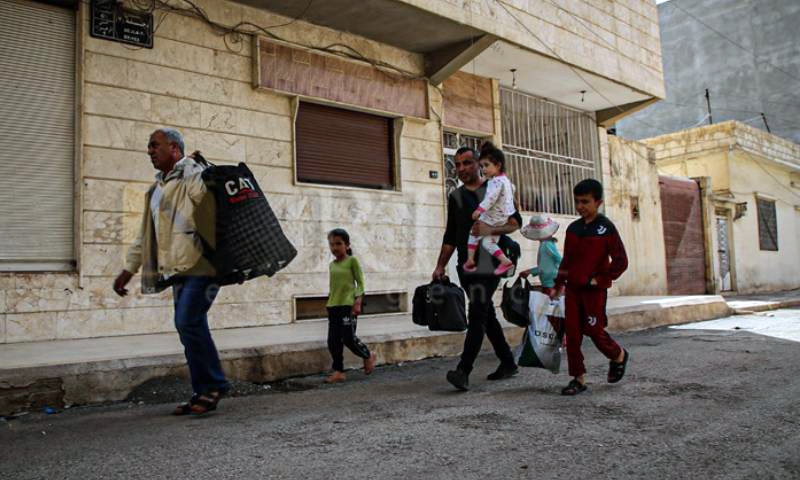Al-Qamishli – Majd al-Salem
“The majority of the neighborhood’s residents fear returning home due to security prosecution and arrests and to evade forced recruitment in the ranks of the Syrian Democratic Forces (SDF). Those who returned are mostly elderly people.” With these words, 40-year-old Abdulrahman recounted to Enab Baladi the difficult conditions faced by the displaced locals of the Tayy neighborhood in al-Qamishli, who fled their properties after the SDF took full control over the area last April.
Abdulrahman, who requested his last name be withheld for security reasons, said that the residents’ fear of returning to the neighborhood has put their properties at the risk of illegal appropriation. Most of the neighborhood’s shops and industrial facilities remained closed, leading to a “massive” decline in commercial activity in the neighborhood.
He added that the neighborhood’s deplorable overall condition in terms of public services and lack of security was a key factor that prompted the Tayy neighborhood residents to contemplate traveling abroad. Moreover, “60 percent of residents are against the idea of going back to the neighborhood,” according to Abdulrahman.
On 26 April, the Autonomous Administration of North and East Syria (AANES) affiliated forces, the Internal Security Forces (ISF), also known as Asayesh, took control of most of the Tayy neighborhood in al-Qamishli, a week after clashing with the Syrian regime-affiliated National Defense Forces (NDF) militia.
Separate batches of the neighborhood’s residents have started to return home and were obliged under a statement by Asayesh to check with security posts to “ensure a safe entry and soundness of properties.”
Most of the al-Qamishli neighborhoods are under the SDF control except the city center area, which includes the security square of regime forces and pro-government NDF militia. The regime’s security square zone is to the south of the Tayy neighborhood roundabout and the Znood neighborhood on the southern borders of al-Qamishli city at a width of 145 meters and a depth of 325 meters starting from Abbas Allawi School towards the city’s southern borders.
Recurrent violations
Adnan, a 32-year-old resident of the Tayy neighborhood, told Enab Baladi that not a week goes by without the SDF carrying out raids on civilian houses claiming to go after NDF militants and their arms. “The SDF fighters are committing mass violations,” Adnan said. Last week, elements of Asayesh cordoned off the western part of the Tayy neighborhood, from al-Hamam Street all the way to al-Quwatli Street in the west.
Asayesh forces have arrested several people from the households of Issa, Abbawi, and Thallaj after raiding their houses and intimidating the inhabitants, according to Adnan, who asked Enab Baladi not to reveal his last name for security concerns.
On 6 June, the state-run Syrian Arab News Agency (SANA) cited unnamed local sources that SDF forces had kidnapped six young men from the Tayy neighborhood and took them to an unknown destination.
Local news social media accounts continuously publish news of violations committed against the Tayy neighborhood residents. The violations range between physical assaults, kidnapping, arrests, and unauthorized raid campaigns against civilian houses.
Last week, a local man was assaulted in the neighborhood’s main street by three armed individuals in civilian clothes. When the residents tried to intervene and help out the attacked man, the three offenders raised their military handguns on people saying they were from the SDF’s General Security, according to Adnan.
Adnan said that the SDF seized all shops owned by the famous Lilo family in al-Qamishli along with their goods. In addition, the SDF took over a blacksmith workshop with its tools, machinery, and metal for an estimated value of “hundreds of millions of Syrian pounds.” The SDF justified its acts on the ground that the shop owners were NDF militants. Moreover, the SDF shut down the al-Shahid pharmacy near one of the NDF’s previous headquarters after confiscating all medicine from it.
Limited service and shortage of bread and household gas
As monitored by Enab Baladi and verified by residents of the Tayy neighborhood, most of the neighborhood’s inhabitants suffer from the unavailability of bread despite the shrinking population.
Malek, a 30-year-old resident of the Tayy neighborhood, pointed out to Enab Baladi that the neighborhood has three bakeries: al-Halbo, Muhajiri, and Deir Ezzor. However, these bakeries’ flour allocations from the regime government have ceased since the area went out of the regime’s control, leading to a bread crisis under the AANES inaction to compensate for the flour shortage.
Malek also talked about the hardship faced by the neighborhood’s residents upon securing gas for household uses. They did not receive their share of gas cylinders for two months now, except for one time and only for a limited number of people as part of a “publicity campaign.”
A culture of vengeance
The spokesman of the Supreme Council of Syrian Tribes and Clans, Sheikh Mudar al-Asaad, commented on the conditions in the Tayy neighborhood by saying that the SDF’s practices there are motivated by a “deeply rooted culture of vengeance.”
Al-Asaad said the SDF’s goal is not “to gain a popular base but to confine people with restrictions and intimidate them.” They want to win people over by force, not by compromise,” through terrorizing people and stealing the fortunes of the region. Besides, the SDF is recruiting the region’s youth to carry out its own projects.
He added that what the SDF had done in the Tayy neighborhood is similar to what it did in the Goyran neighborhood, al-Shaddadi, Tall al-Shair, and al-Dashisha towns, and the al-Fadhil village in the al-Hasakah governorate.
The Syrian clans have condemned the SDF’s acts against the people of the Jazeera region, al-Asaad said.
The SDF’s “vengeance culture” has been generating hatred in the region and creating unnecessary security tensions; at the same time, the city of al-Qamishli, more than ever before, needs social security to achieve stability on the economic and service levels to spare the residents further sufferings.

